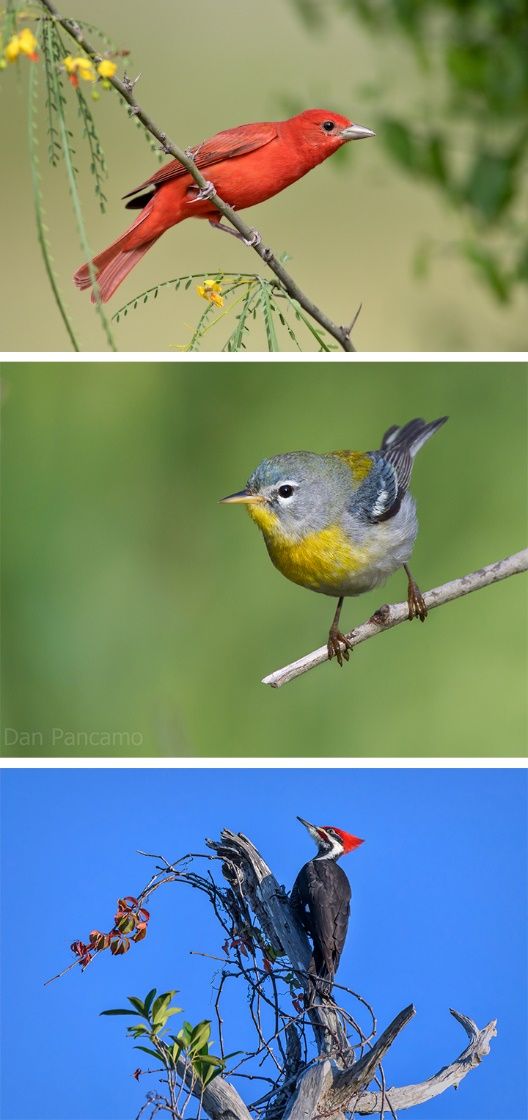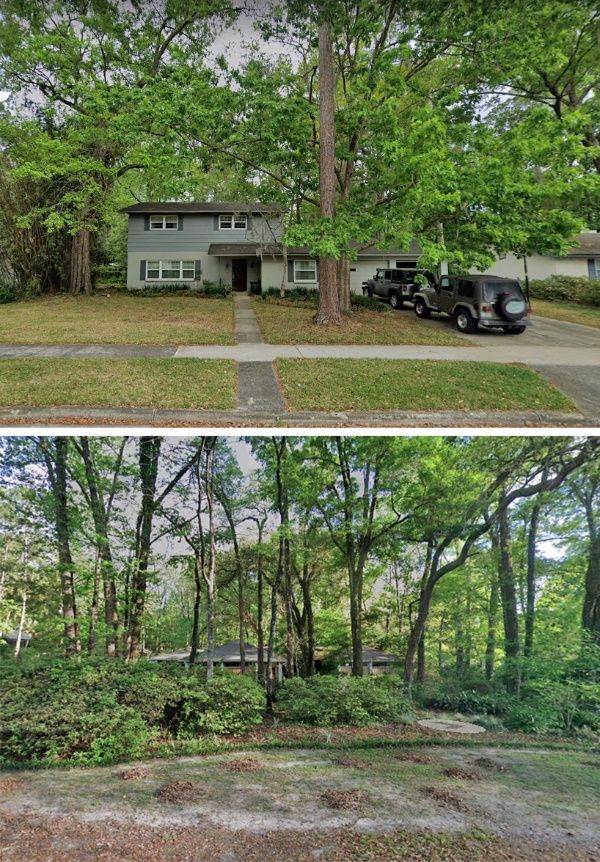Introduction
This fact sheet reports on the use of suburban habitat by specialist forest birds during the breeding season. Information in this fact sheet is relevant to homeowners, environmental consultants, developers, and city/county officials interested in conserving urban bird habitat. Forest-specialist birds tend to have specific resource and habitat requirements. They are reported to breed primarily in large, undisturbed patches of forest and are, therefore, threatened by changes to their habitat including increased urban development (Archer et al. 2019; Robinson 1994). Forest fragmentation, resulting from urbanization, divides continuous landscapes into smaller patches (Fahrig 2003) and poses a variety of challenges to forest birds. For example, birds will typically only build their nests in areas where food is abundant (Chamberlain et al. 2008; Narango et al. 2017), and the abundance of food is often reduced when fragmentation limits the presence and structure of vegetation (Fenoglio, Rossetti, and Videla 2020). Therefore, urban development in or near large forest patches can impact the breeding habitat suitability of an area for forest specialist birds.

Credit: A) Andrej Chudy https://creativecommons.org/licenses/by-nc-sa/2.0/; B) Dan Pancamo https://creativecommons.org/licenses/by-nc-sa/2.0/; C) Diana Robinson https://creativecommons.org/licenses/by-nc-sa/2.0/
Developed areas, however, cannot be studied or managed as one continuous habitat (Savage et al. 2015). The composition and structure of vegetation can differ substantially among land-use types and even from yard to yard (Savage et al. 2015). This variation means that some urban green spaces, including residential neighborhoods, may contain enough vegetation and food to potentially serve as breeding habitat for specialist species (Goddard et al. 2012; Archer et al. 2019; Wood and Esaian 2020).
According to the Florida 2070 project (1000 Friends of Florida, UF GeoPlan Center, and Florida Department of Agriculture and Consumer Services 2016), the amount of developed land in Florida is projected to increase to 33% by 2070. Therefore, more natural areas will be fragmented and developed, so it is urgent that we begin managing urban vegetation to preserve individual species and local populations of native birds.
This fact sheet summarizes a study that determined the occurrence and habitat selection of pileated woodpeckers (Dryocopus pileatus), summer tanagers (Piranga rubra) (Figure 1), and northern parulas (Setophaga americana) in two suburban neighborhoods in Gainesville, Florida (Figure 1). All of these birds breed in Florida and have been previously considered interior-forest specialists (Archer et al. 2019; Moorman et al. 2019; Robinson 1994); however, they have been repeatedly observed in suburban areas with high retention of vegetation, such as in Gainesville, Florida (https://ebird.org/region/US-FL-001). Pileated woodpeckers are a non-migratory species. They nest and roost in cavities that they excavate in large, dead trees (Hoyt 1957; Tomasevic and Marzluff 2020). Summer tanagers and northern parulas are Neotropical migrant songbirds that breed in the United States and migrate to Central or South America for the winter (Isler and Isler 1987; Morse 1967). Summer tanagers tend to nest on branches that overhang gaps in the forest (i.e., areas lacking large trees) (Rosenberg et al. 1982). Northern parulas typically nest in large trees and use materials such as Spanish moss for nesting (Bent 1953; Finch 2010).
Study
The study was conducted in two residential neighborhoods in Gainesville, Florida: Suburban Heights and West Hills. These neighborhoods were selected because they contain significant vegetation (> 30% tree canopy cover) and have variation in terms of vegetation from yard to yard. We conducted transect surveys to determine if these species could be consistently detected in the study areas throughout the breeding season. Transects are a survey method in which an observer walks along a set path and makes note of detections (visual or auditory) of the survey species within a certain distance of the street. We also conducted vegetative surveys at multiple spatial scales to better understand the vegetation parameters behind breeding habitat selection for these species.

Credit: Natalie Pegg
During transect surveys, we observed that pileated woodpeckers (77 detections), summer tanagers (51 detections), and northern parulas (660 detections) consistently were present within the two study neighborhoods, and they were each detected significantly more times in areas that contained dense vegetation from the ground to the canopy and in areas with increasing amounts of large oaks (which were over 20 feet tall).
Focusing on individual species, we highlight some vegetation features that seemed to influence whether a given species occurred more often along transects in the neighborhoods. We found that summer tanagers were more likely to occur in areas closer to remnant forest patches and farther from major roads. They also were found more commonly in areas containing more hardwood trees over 20 feet tall, more live oaks, more total oaks, more longleaf pines, and more total softwoods. Northern parulas were found in areas with more live oaks, increased tree canopy cover, and more total oaks. Pileated woodpeckers were found in areas farther from major roads, with increased tree canopy cover, with more total oaks, and with more tree snags over 20 feet tall.
Given the results of this study, we make recommendations on how homeowners and other city decision makers can provide breeding habitat for pileated woodpeckers, northern parulas, and summer tanagers.
1. Maintain residential tree canopy cover and understory vegetation
Forest bird habitat can be improved in urban areas through the management of residential yards and neighborhoods. Understory and canopy vegetation are both important components of quality bird habitat (Xie et al. 2016). Although certain species may nest and forage in one forest stratum (i.e., ground, understory, or canopy), vegetation in the other strata often directly impact the abundance of insects and determine whether forest birds will be present (Threllfall et al. 2016). Therefore, transitioning from monoculture turf grass to natural yards with trees, shrubs, and native vegetation can be directly beneficial to these species (Goddard et al. 2010; Lerman et al. 2021). However, because many homeowners prefer the aesthetic of manicured turf grass, there are other important efforts that can be made within residential areas to provide quality habitat to specialist species. For example, retaining large trees and non-hazardous dead trees can help provide nesting habitat for pileated woodpeckers, northern parulas, and summer tanagers.
2. Protect urban forest fragments
Birds often use residential areas because of their proximity to urban forest patches or because they are used as a connector between urban greenspaces (Goddard et al. 2010). For example, we found that summer tanagers occurred more often in areas within 500 meters of forest patches of at least ¼ acre, suggesting that they may only be there because of the nearby forest patch. Further, all three species preferred areas that had increased amounts of understory and tree canopy cover, and typically forest fragments have more understory and tree canopy cover than yards with homes. Therefore, retaining and managing forest fragments should be a key component of conserving local populations of pileated woodpeckers, northern parulas, and summer tanagers.
Conclusions
Breeding bird behavior is variable across different scales and geographical ranges. Although certain species may act as specialists in one region, they could be using residential areas with remnant vegetation in another. Pileated woodpeckers, northern parulas, and summer tanagers are using wooded and heavily vegetated residential areas in Gainesville, Florida. The majority of urban conservation is focused on forest fragments and urban green spaces, but it is clear that vegetation in residential areas is another important resource to manage. Urban planners, developers, homeowner’s associations, and even individual homeowners can make a difference in preserving critical forest bird habitat simply by retaining native vegetation as often as possible in urban neighborhoods.
List of Citations
1000 Friends of Florida, Center, UF GeoPlan Center, Florida Department of Agriculture and Consumer Services. (2016). Mapping Florida's Future—Alternative Patterns of Development in 2070.
Amaya-Espinel, J. D. and M. E. Hostetler. 2019. “The Value of Small Forest Fragments and Urban Tree Canopy for Neotropical Migrant Birds during Winter and Migration Seasons in Latin American Countries: A Systematic Review.” Landscape and Urban Planning 190. https://doi.org/10.1016/j.landurbplan.2019.103592
Archer, J. M. J., M. E. Hostetler, G. Acomb, and R. Blair. 2019. “A Systematic Review of Forest Bird Occurrence in North American Forest Fragments and the Built Environment.” Landscape and Urban Planning 185:1–23. https://doi.org/10.1016/j.landurbplan.2019.01.005
Bent, A. C. 1953. “Life Histories of North American Wood Warblers.” United States National Museum Bulletin 211. https://doi.org/10.5479/si.03629236.203.1
Chamberlain, D. E., A. R. Cannon, M. P. Toms, D. I. Leech, B. J. Hatchwell, and K. J. Gaston. 2009. “Avian Productivity in Urban Landscapes: A Review and Meta-Analysis.” Ibis 151:1–18. https://doi.org/10.1111/j.1474-919X.2008.00899.x
Fahrig, L. 2003. “Effects of Habitat Fragmentation on Biodiversity.” Annual Review of Ecology, Evolution, and Systematics 34:487–515. https://doi.org/10.1146/annurev.ecolsys.34.011802.132419
Fenoglio, M. S., M. R. Rossetti, and M. Videla. 2020. “Negative Effects of Urbanization on Terrestrial Arthropod Communities: A Meta-Analysis.” Global Ecology and Biogeography 29 (8): 1412–1429. https://doi.org/10.1111/geb.13107
Finch, D. M. 2010. “Status and Management of Neotropical Migratory Birds: September 21–25, 1992, Estes Park Center YMCA of the Rockies, Colorado.” General technical report RM. 229:316–319.
Fontúrbel, F. E., J. I. Orellana, G. B. Rodríguez-Gómez, C. A. Tabilo, and G. J. Castaño-Villa. 2020. “Habitat Disturbance Can Alter Forest Understory Bird Activity Patterns: A Regional-Scale Assessment with Camera-Traps.” Forest Ecology and Management 479. https://doi.org/10.1016/j.foreco.2020.118618
Goddard, M. A., A. J. Dougill, and T. G. Benton. 2010. “Scaling up from Gardens: Biodiversity Conservation in Urban Environments.” Trends in Ecology & Evolution 25:90–98. https://doi.org/10.1016/j.tree.2009.07.016
Hoyt, S. F. 1957. “The Ecology of the Pileated Woodpecker.” Ecology 38:246–256. https://doi.org/10.2307/1931683
Isler, M. L., and P. R. Isler. 1987. The Tanagers: Natural History, Distribution, and Identification. Smithsonian Institution Press.
Lerman, S. B., D. L. Narango, M. L. Avolio, A. R. Bratt, J. M. Engebreston, P. M. Groffman, S. J. Hall, et al. 2021. “Residential Yard Management and Landscape Cover Affect Urban Bird Community Diversity across the Continental USA.” Ecological Applications 31(8). https://doi.org/10.1002/eap.2455
Moorman, C. E., and D. C. Guynn, Jr.. 2001. “Effects of Group-Selection Opening Size on Breeding Bird Habitat Use in a Bottomland Forest.” Ecological Applications 11 (6): 1680–1691. https://doi.org/10.1890/1051-0761(2001)011[1680:EOGSOS]2.0.CO;2
Morse, D. H. 1967. “Competitive Relationships between Parula Warblers and Other Species during the Breeding Season.” Auk. 84:490–502. https://doi.org/10.2307/4083331
Narango, D. L., D. W. Tallamy, and P. P. Marra. 2017. “Native Plants Improve Breeding and Foraging Habitat for an Insectivorous Bird.” Biological Conservation. 213, 42–50. https://doi.org/10.1016/j.biocon.2017.06.029
Robinson, S. K. 1994. “Nesting Success of Forest Songbirds in Northwestern Illinois Draft Final Report W-115-R-3.” Illinois Natural History Survey Center for Wildlife Ecology.
Rosenberg, K. V., R. D. Omhart, and B. W. Anderson. 1982. “Community Organization of Riparian Breeding Birds: Response to an Annual Resource Peak.” Auk 99:260–274. https://academic.oup.com/auk/article/99/2/260/5187862
Savage, A. M., B. Hackett, B. Guenard, E. K. Youngsteadt, and R. R. Dunn. 2015. “Fine-Scale Heterogeneity across Manhattan's Urban Habitat Mosaic Is Associated with Variation in Ant Composition and Richness.” Insect Conservation and Diversity 8:216–228. https://doi.org/10.1111/icad.12098
Threlfall, C. G., A. Ossola, A. K. Hahs, N. S. G. Williams, L. Wilson, and S. J. Liveslev. 2016. “Variation in Vegetation Structure and Composition across Urban Green Space Types.” Frontiers in Ecology and Evolution 4. https://doi.org/10.3389/fevo.2016.00066
Tomasevic, J. A., and J. M. Marzluff. 2020. “Roosting, Reproduction, and Survivorship of Pileated Woodpeckers (Dryocopus pileatus) in a Suburban Setting.” Avian Conservation and Ecology 15. https://doi.org/10.5751/ACE-01547-150113
Wood, E. M., and S. Esaian. 2020. “The Importance of Street Trees to Urban Avifauna.” Ecological Applications 30. https://doi.org/10.1002/eap.2149
Xie, S., F. Lu, L. Cao, W. Zhou, and Z. Ouyang. 2016. “Multi-Scale Factors Influencing the Characteristics of Avian Communities in Urban Parks across Beijing during the Breeding Season.” Scientific Reports 6:29350. https://doi.org/10.1038/srep29350